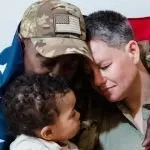All About U.S. Veteran Benefits
The United States Department of Veterans Affairs (VA) is a government-run military veteran advantage system with Cabinet-level status. It is administered by the United States Secretary of Veterans Affairs.
History
The Continental Congress of 1776 encouraged enlistments during the Revolutionary War providing retirement benefits for soldiers who were disabled. Direct medical and hospital care directed at veterans in the early days of this republic ended up being given by the specific states and communities. In 1811, the domiciliary that is first medical facility for veterans was authorized by the government, although not exposed until 1834. Within the 19th century, the nation?s veteran?s assistance system had been expanded to add advantages and retirement benefits not only for veterans, but also their widows and dependents.
Following the Civil War, many state veterans? houses were founded. Since domiciliary care ended up being offered at all continuing state veterans domiciles, incidental medical and hospital treatment was given to all injuries and diseases, whether or otherwise not of service origin. Indigent and disabled veterans regarding the Civil War, Indian Wars, Spanish-American War, and Mexican Border period as well as discharged regular people regarding the Armed Forces had been looked after at these homes.
Congress established a new system of veteran?s benefits if the United States entered World War I in 1917. Included were programs for disability compensation, insurance coverage for servicepersons and veterans, and vocational rehabilitation for the disabled. The Bureau of Pensions of the Interior Department, and the National Home for Disabled Volunteer Soldiers by the 1920s, the various benefits were administered by three different federal agencies: the Veterans Bureau.
The establishment associated with the Veterans Administration came in 1930 whenever Congress authorized the president to ?combine and coordinate Government activities war that is affecting?. The three component agencies became bureaus within the Veterans Administration. Brigadier General Frank T. Hines, who directed the Veterans Bureau for seven years, was named while the first Administrator of Veterans Affairs, employment he held until 1945.
The close of World War II led to not merely a vast upsurge in the veteran population, but in addition many new advantages enacted by Congress for veterans for the war. The VA had to contend with aging World War I veterans in addition, during the late 1940s. Throughout that right time, ?the clientele associated with VA increased nearly fivefold with an addition of nearly 15,000,000 World War II veterans and roughly 4,000,000 World War I veterans?. Prior to World War II, in response to scandals at the Veterans Bureau, programs that maintained veterans were centralized in Washington, D.C. This centralization caused delays and bottlenecks while the agency tried to provide the World War II veterans. As a result, the VA experienced a decentralization procedure, giving more authority toward the field workplaces.
The World War II GI Bill was finalized into legislation on June 22, 1944, by President Franklin D. Roosevelt.
The VA healthcare system has exploded from 54 hospitals in 1930 to incorporate 171 centers that are medical a lot more than 700 outpatient, community, and outreach clinics; 126 medical home care devices; and 35 domiciliaries. VA medical care facilities provide a diverse spectrum of medical, medical, and rehabilitative care. The responsibilities and advantages programs of the Veterans Administration grew enormously during the after six decades.
Further assistance that is educational were passed for the benefit of veterans regarding the Korean War, the Vietnam age, the development of an ?all-volunteer force? into the 1970s (following the end of conscription in the United States in 1973), the Persian Gulf War, and people whom served following attacks of September 11, 2001.
The Department of Veterans Affairs Act of 1988 changed the former Veterans Administration, an independent government agency established in 1930, primarily to see towards the requirements of World War I veterans, into a Cabinet-level Department of Veterans Affairs. It was finalized into law by President Ronald Reagan on October 25, 1988, but actually came into impact beneath the term of his successor, George H. W. Bush, on March 15, 1989.
The Department of Veterans Affairs was made due to nearly one third regarding the populace being entitled to veteran?s benefits. Its proponents argued that due to the large number of Americans affected by the VA, it required an administrator that has direct access is the president.
In their major reform period of 1995?2000, the Veterans Health Administration (VHA) applied universal care that is primary shut 55 percent of the severe care medical center beds, increased clients treated by 24 percent, had a 48 percent increase in ambulatory care visits, and reduced staffing by 12per cent. By 2000, the VHA had 10,000 less employees compared to 1995 and a 104 percent escalation in patients addressed since 1995, and had was able to retain the exact same cost per patient-day, while other facilities? expenses had increased over 30 percent to 40 percent during the period that is same.
Veterans Health Administration scandal of 2014
In May 2014, major problems with scheduling access that is timely medical care became public. At the time of May 2014, at least 40 United States Armed Forces veterans died waiting for care during the Phoenix, Arizona Veterans Health Administration facilities, and an investigation of delays in treatment through the Veterans Health Administration system has been conducted by the Veterans Affairs Inspector General. On May 30, 2014, Secretary of Veterans Affairs Eric Shinseki resigned from workplace due to th e fallout from the scandal, saying he could not explain the shortage of integrity among some leaders in VA health care facilities.
?That breach of integrity is irresponsible, it?s indefensible, and unacceptable if you ask me. I said when this example began days to months ago that I thought the situation had been limited and isolated because we thought that. We not any longer think it. It?s systemic. I was too trusting of some and I also accepted as accurate reports that we now understand to happen misleading with regard to patient wait times,? Shinseki said in a statement. He stated he could perhaps not defend what happened for it and he would because it was indefensible, but he could take responsibility.
Function
Its main function is to help Veterans in their time after service by giving advantages and support. A current effort in the Department would be to avoid and end Veterans? homelessness. The VA works with the United States Interagency Council on Homelessness to deal with these issues. The Secretary sits regarding the Council and it is dedicated to closing Veteran?s homelessness by 2015 as organized in Opening Doors: Federal Strategic Plan to Prevent and End Homelessness, released in 2010.
Benefits
For VA advantages for PTSD, see Veterans benefits for post-traumatic stress condition within the United States.
The VA, through its Veterans Benefits Administration (VBA), provides a variety of solutions for veterans disability that is including, retirement, training, home loans, life insurance, vocational, rehabilitation, survivors? advantages, health care, and burial benefits.
As is typical in almost any time of war, recently there has been an elevated demand for nursing house beds, injury rehabilitation, and health care that is mental. VA categorizes veterans into eight priority teams and many additional subgroups, centered on factors such as for example service-connected disabilities, and something?s income and assets (adjusted to cost that is local of).
Veterans with a 50 percent or more disability that is service-connected decided by a VA regional office ?rating board? (e.g., losing a limb in battle, PTSD, etc.) are offered comprehensive care and medicine at no cost. Veterans with lower qualifying factors whom exceed a income that is pre-defined need certainly to make co-payments for take care of non-service-connected illnesses and spend $9 per 30-day supply for every prescription drugs. VA dental and home that is nursing advantages are m ore restricted.
Reservists and National Guard personnel who served stateside in peacetime settings or have no disabilities that are service-related usually do not qualify for VA health benefits.
VA?s budget has been forced to the restriction in recent years by the War on Terrorism. In December 2004, it had been commonly reported that VA?s money crisis had become so serious so it could no longer offer disability ratings to veterans in a fashion that is timely. This really is a challenge because until veterans are completely transitioned through the active-duty TRICARE healthcare system to VA, they truly are by themselves pertaining to numerous health care costs.
The VA?s backlog of pending disability claims under review (a procedure referred to as ?adjudication?) peaked at 421,000 in 2001, and bottomed away at 254,000 in 2003, but crept back up to 340,000 in 2005.
No copayment is required for VA solutions for veterans with military-related conditions that are medical. VA-recognized service-connected disabilities consist of issues that started or had been aggravated due to military solution. Veteran solution companies including the American Legion, Veterans of Foreign Wars, and American that is disabled Veterans also state-operated Veterans Affairs workplaces and County Veteran Service Officers (CVSO), have now been recognized to help veterans in the process of getting care from the VA.
In his spending plan proposition for financial 12 months 2009, President George W. Bush asked for $38.7 billion?or 86.5 percent of the total Veterans Affairs budget?for veteran medical care alone.
Into the 2011 expenses of War report from Brown University, researchers projected that the cost of looking after veterans of the War on Terror would top 30 or 40 years following the end of combat operations. Additionally they predicted that medical and disability expenses would total between $600 billion and $1 trillion for the thousands and thousands addressed by the Department of Veterans Affairs.
The New GI Bill
The brand new GI Bill authored by Sen. Jim Webb (D-VA) doubled GI Bill college advantages while supplying a extension that is 13-week federal unemployment advantages. The brand new GI Bill doubled the worth of this benefit to approximately $90,000 up from $40,000. In-state public universities really are covered to deliver complete scholarships for veterans beneath the brand new training package. For anyone veterans who served at the very least three years a monthly housing stipend was additionally included with regulations.
Upon passage through of the new GI Bill President George W. Bush stated ?Our country does not have any greater responsibility than to help our men and women in uniform?especially because we?re at war… This bill shows the US people that even in an election year, Republicans and Democrats can come together to support our troops and their loved ones?, which highlighted that the GI that is new Bill been overwhelmingly supported by both events in the U.S. Congress.
Congress and President Barack Obama stretched this new GI Bill in August 2009 at the cost of roughly $70 billion over the next ten years. Upon passing the GI Bill expansion President Obama claimed his support associated with the fighting forces for the United States by saying ?Over the last eight years, they will have endured trip after tour of responsibility in dangerous and remote places… they have experienced combat that is grueling through the streets of Fallujah towards the harsh landscapes of Helmand province. They?ve adjusted to complex insurgencies, safeguarded local populations and trained security that is foreign.?
The Pentagon worked closely with Congressional lawmakers to make certain military families had been protected into the expansion of the law. In doing this, army officials worked non-stop to incorporate a provision to give the GI Bill towards the spouse that is surviving kiddies of servicemembers killed whilst in combat.
This provision had been extremely well-liked by the Pentagon which authorized the Department of Defense (DoD) to allow people who, on or after August 1, 2009, have served at least six years within the Armed Forces and who accept provide at least another four years in the U.S. Armed Forces to transfer entitlement that is unused their surviving partner. Servicemembers reaching 10 year wedding anniversaries could elect to move the benefit to any s that are dependent( (spouse, children).
National Cemetery Administration
In 1973, the Veterans Administration assumed another responsibility that is major the National Cemetery System (NCS) (aside from Arlington National Cemetery) ended up being transported to the Veterans Administration from the Department of the Army.
The VA was faced with the procedure for the NCS, like the marking of graves of all of the people in nationwide and State cemeteries (therefore the graves of veterans in personal cemeteries, upon request) as well and administering the State Cemetery Grants Program. The VA?s National Cemetery Administration keeps 131 cemeteries that are national 39 states (and Puerto Rico) in addition to 33 soldier?s lots and monument websites.
The Department of the Army maintains two cemeteries that are national the Arlington National Cemetery therefore the U.S. Soldiers? & Airmen?s Home National Cemetery. Numerous states established state veterans cemeteries. The American Battle Monuments Commission maintains 25 overseas army cemeteries that serve as resting places for almost 125,000 US war dead; on pills associated with the Missing that memorialize more than 94,000 U.S. servicemen and ladies; and through 25 memorials, monuments and markers.
Fourteen nationwide cemeteries are maintained by the National Park Service.


